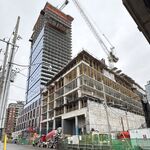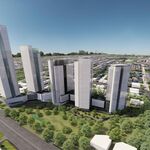Interesting reading through the past few pages. AV's are coming but I don't think its the silver bullet to our problems as advocates of the technology like to claim.
The idea that AV's resolves congestion needs to be thrown out of the window immediately, or else we will enter an era of adoption of this disruptive technology with false expectations. There is every reason to expect that AV's will lead to more congestion as you are adding multiple more trips per vehicle compared to the present. Currently when someone drives to work, they leave their vehicle parked at their office's parking lot, and likewise when they return home, the vehicle is parked in their driveway. Where does the AV go when it is not being used? They may immediately go and pick someone else up, but afterwards when peak demand period is over, they must drive back to the AV parking garage (and depart from said garage for service in evening peak hours). That is multiple more trips you are adding per day, congesting our streets.
And no, you can't simultaneously size an AV fleet to serve as an all-day taxi service AND replace public transit + conventional car ownership model, jurisdictions must choose one or the other. Why? Because in order to replace public transit and conventional car ownership, the AV fleet must be sized to meet peak hour demand, or else people simply won't be able to get to work - and the fleet size required for peak hour is several magnitudes larger than the fleet you require for an all-day taxi service.
I think to get this right, jurisdictions must be very deliberate with what they are looking to accomplish with AVs. They cannot be thinking that embracing mass-adoption will magically resolve their problems because 'efficiency'. The suggestion that the GO rail corridors will be made obsolete for instance, is just silly. We are planning TOD around GO stations to point where the 1-2km radius surrounding GO station areas will in practice one-day be 20-30k mini-cities in their own right - I don't want to be transporting those people on highways to downtown Toronto. Rail capacity is much greater than highway capacity, and much much much much much greater capacity than the local road network. Instead, a jurisdiction should be planning around how to use AV ride sharing service to serve as first- and last-mile transit service for people to get to and from the GO station, which is actually a problem that could be solved with AVs.
Likewise, surface transit routes (buses specifically) need to be looked at with how they can be upgraded (read: not replaced!) with AVs. Toronto's successful surface transit network is largely successful in part due to our arterial grid network. My thinking is that upgrading buses with AV buses (unions be damned) will allow for increased efficiency, frequency, and operational regularity (no more bus bunching?) - and this is something that we can begin preparing for today by incrementally adopting features of BRT systems onto our arterial bus routes. Things like level boarding, signal priority, dedicated (or even separated) bus lanes, all-door boarding, off-board fare collection, would improve the attractiveness and operational efficiency of our bus corridors, regardless if the bus vehicle is autonomous or not. (AV technology doesn't resolve human induced problems like people lining up to board a bus). If I was in charge of transportation planning, I would also be deliberately looking at how AVs can be used for servicing areas such as business parks that are too impractical and costly to service with conventional surface routes, such as business parks. If an AV bus can pick up fifteen passengers at Don Mills station, and take the destination inputs of each passenger and design a route that drops each passenger off in front of their office building, while skipping every other designated stop on the route, that would be a game-changer for last-mile problems.
And finally, those advocating for transit technologies to resolve all our problems need to be careful that they don't repeat the mistakes of modernist era engineers, architects, and pioneers of industry. Efficiency =/= Quality. Simply upgrading the efficiency of our roadway network to highway systems did not improve the quality of our urban realm or quality of life within our cities. We lost a lot of space within our public realm in dedication to our automobile gods and we're only beginning to come to grips with that in North America. And I definitely worry that AVs will spur a new wave of urban sprawl. But, I believe there is an opportunity here to be deliberately planning for a future with AVs that includes a reclaiming of the public realm from vehicles. No more surface parking in built-up areas, on-street parking, driveways, dedication of lanes to public transit routes (that may be operating with AV technology), as well as a significant trimming of road ROW including full pedestrianizing of some roads. However, these outcomes if desired, won't be achieved by rushing headfirst into mass AV adoption.





